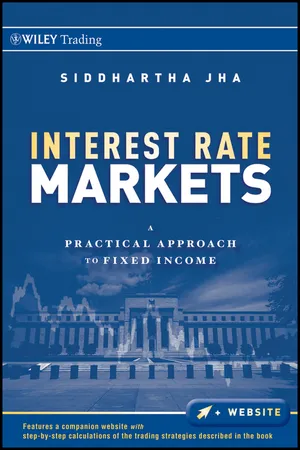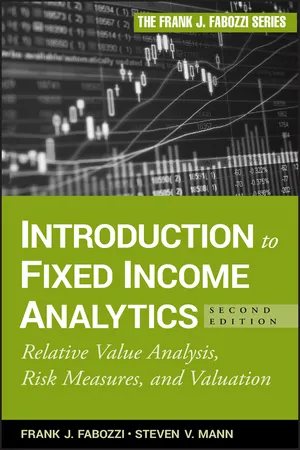Economics
Interest Rate Volatility
Interest rate volatility refers to the degree of fluctuation in interest rates over a specific period. It reflects the uncertainty and risk associated with changes in interest rates, impacting borrowing costs, investment decisions, and overall economic stability. High interest rate volatility can lead to market instability and challenges for businesses and consumers in managing their finances.
Written by Perlego with AI-assistance
Related key terms
3 Key excerpts on "Interest Rate Volatility"
- eBook - ePub
- Frank J. Fabozzi(Author)
- 2012(Publication Date)
- Wiley(Publisher)
The Concept and Measures of Interest Rate Volatility ALEXANDER LEVIN, PhD Director, Financial Engineering, Andrew Davidson & Co., Inc.Abstract: The knowledge of interest rates and cash flows represents the basis for valuation of fixed income financial instruments. In reality, not only are future interest rates random, but the future cash flows of many securitized investments are also uncertain, as they depend (are “contingent”) on interest rates. Valuation of rate options and embedded option bonds, including MBS and ABS, requires sophisticated models of this randomness.In this entry, we introduce the concepts of market volatility and discuss how it is measured. The dynamics of rates are subject to market forces, mean reversion, and combinations of diffusions and jumps.BASIC DEFINITIONS AND FIRST FINDINGSWe can't tell in advance what interest rates will be. Investors may be either enriched or bankrupted from sudden changes in interest rates. Financial institutions devote considerable resources to risk management and hedging. Yet, if future interest rates were deterministic, there would be no need to hedge. Coping with uncertainty is a central feature of investment markets.The pricing of options and embedded-options instruments utilizes a statistical concept to describe the magnitude of potential interest rates changes. The key notion is the volatility of interest rates. While this term conjures up images of instability, flares of activity, and unpredict-ability, it is actually a very specific description of the range of possible outcomes. More precisely, volatility can be defined as the standard deviation of a rate's annualized daily increments. Table 1 - eBook - ePub
Interest Rate Markets
A Practical Approach to Fixed Income
- Siddhartha Jha(Author)
- 2011(Publication Date)
- Wiley(Publisher)
The ebb and flow of implied volatilities is first and foremost driven by realized volatility—as markets go through periods of stress and calm, implied volatilities are driven along with them. Realized volatility in the interest rate market stems from the interaction of Fed monetary policy with the future expected path of the economy and inflation. As would be intuitive, when there is a great deal of uncertainty about the direction of the economy, realized volatility in the rates space is higher. Another source of uncertainty for the rates market tends to be the question of how the Fed may respond to conflicts in its mandates to maintain maximum employment and stable prices. Furthermore, the time period over which these uncertain views are likely to play out contributes to the structure of volatility in the market. For example, if the Fed is likely to stay on hold for at least a year but the direction of the economy is very uncertain after two to five years, this situation will be reflected in higher volatility for intermediate rates rather than for very short rates. Uncertainty about the fiscal situation and in particular about the sustainability of government spending with regard to inflation may push volatility even farther out toward 10-year and 30-year rates. This assessment of sources of uncertainty in the broad economy and Fed policy as well as the likely tenor of these uncertainties forms the starting point about taking a structural view on Interest Rate Volatility. Another source of volatility, both realized and implied, is the shape of the curve. In general, a steep curve is conducive to higher volatility. The reasons for this are difficult to prove empirically, but some possible reasons are that steeper curves incorporate more uncertainty as part of term premium, in addition to incorporating higher rates in the future, which adds to expected volatility. Flat curves, however, have little term premium and incorporate expectations of steady rates in the future - eBook - ePub
Introduction to Fixed Income Analytics
Relative Value Analysis, Risk Measures and Valuation
- Frank J. Fabozzi, Steven V. Mann(Authors)
- 2010(Publication Date)
- Wiley(Publisher)
In order to understand the dynamics of the yield curve, it is necessary to characterize interest rate movements by factors. We must also consider correlations among these factors if they are not correlated. One possible factor is the short rate. The Federal Reserve Board’s use of the short rate as a means to control inflation as part of its monetary policy makes the short rate a source of information about inflationary expectations. Changes in the short rate influence spot rates for other maturities. While the rates at these maturities are affected by other factors as well, none of these factors is more influential than the short rate.It is customary for a fixed income analyst to think of yield curve movements in terms of changes in level, slope, and curvature. A change in level denotes a parallel shift in the yield curve. A change in slope refers to a flattening or steepening of the yield curve. A change in curvature refers to changes in concavity. These three types of changes in the yield curve’s shape are not independent. Specifically, an upward (downward) shift in the yield curve’s level is associated with a flattening (steepening) of its slope and a decrease (increase) of its curvature.Term Structure of Volatility
In this section, we introduce the term structure of volatility, which represents the volatility of the yields of benchmark bonds of various maturities plotted against term to maturity. Rather than the level of yield, we plot the volatility of yields across the maturity spectrum. Exhibit 2.10 presents a Bloomberg screen of the VOL function. In the box on the right-hand side of the screen, the yield volatilities of various maturity buckets—1-3, 3-5, 5-7, 7-10, and 10+ years are shown for sample periods of varying lengths. One pattern apparent is that volatilities generally decrease with maturity. For every sample period, volatility declines monotonically with maturity.EXHIBIT 2.10Bloomberg Screen of the VOL Function© 2009 Bloomberg Finance L.P. All rights reserved. Used with permission.EXHIBIT 2.11Volatility of Interest Rates©
Index pages curate the most relevant extracts from our library of academic textbooks. They’ve been created using an in-house natural language model (NLM), each adding context and meaning to key research topics.


